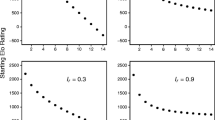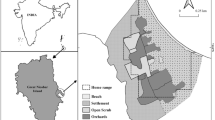Abstract
Female bonnet macaques are ranked according to naturally occurring dyadic aggressive interactions. Several possible correlates of these ranks are examined. Maternal rank and early life history are found to be highly correlated with rank. In addition, a number of social relationships (female/female presentations, female/female mounts, contact among females and aggression) are found to be related to rank. The meaning of rank outside of head to head encounters is discussed.
Similar content being viewed by others
References
Alvarez, F., 1975. Social hierarchy under different criteria in groups of squirrel monkeys,Saimiri sciureus. Primates, 16: 437–455.
Bernstein, I. S., 1963. Social activities related to rhesus monkey consort behavior.Psychol. Rep., 13: 375–379.
————,R. J. Schusterman &L. G. Sharpe, 1963. A Comparison rhesus monkey and gibbon responses to unfamiliar situations.J. Comp. Physiol. Psychol., 56: 914–916.
Carpenter, C. R., 1942. Sexual behavior of free ranging rhesus monkeys (Macaca mulatta). I. Specimens, procedures and behavioral characteristics of estrus. II. Periodicity of estrus, homosexual, autoerotic and non-conformist behavior.J. Comp. Psychol., 33: 113–162.
Gouzoules, H., 1975. Maternal rank and early social interactions of infant stumptail macaques,Macaca arctoides. Primates, 16: 405–418.
Hall, K. R. L. &I. DeVore, 1965. Baboon social behavior. In:Primate Behavior,I. DeVore (ed.), Holt, Rinehart & Winston, New York, pp. 53–110.
Hausfater, G., 1975.Dominance and Reproduction in Baboons (Papio cynocephalus).A Quantitative Analysis. S. Karger, Basel.
Kawai, M., 1958. On the rank system in natural group of Japanese monkey. I. The basic and dependent rank.Primates, 1: 111–130.
————, 1960. A field experiment on the process of group formation in the Japanese monkey (Macaca fuscata) and the releasing of the group at Ohirayama.Primates, 2: 181–255.
Koyama, N., 1973. Dominance, grooming and clasped-sleeping relationships among bonnet monkeys in India.Primates, 14: 225–244.
Marler, P., 1965. Communication in monkeys and apes. In:Primate Behavior,I. DeVore (ed.), Holt, Rinehart & Winston, New York, pp. 544–584.
Maroney, R. J., J. M. Warren &M. M. Sinha, 1959. Stability of social hierarchies in monkeys (Macaca mulatta).J. Soc. Psychol., 50: 285–293.
Maslow, A. H., 1934. The role of dominance in the social and sexual behavior of infrahuman primates. I. Observations at Vilas Park Zoo. III. A theory of sexual behavior of infrahuman primates.J. Genet. Psychol., 48: 261–277, 310–338.
Poirier, F. E., 1970. Dominance structure of the Nilgiri langur (Presbytis johnii) of South India.Folia Primatol., 12: 161–186.
Rahaman, H. &M. D. Parthasarathy, 1969. Studies on the social behaviour of Bonnet monkeys (Macaca radiata).Primates, 10: 149–162.
Richards, S. M., 1974. The concept of dominance and methods of assessment.Anim. Behav., 22: 914–930.
Rowell, T. E., 1966. Hierarchy in the organization of a captive baboon troop.Anim. Behav., 14: 431–443.
————, 1969. Intra-sexual behavior and female reproductive cycles of baboons (Papio anubis).Anim. Behav., 17: 159–167.
Sade, D. S., 1972a. A longitudinal study of social behavior of rhesus monkeys. In:The Functional and Evolutionary Biology of Primates,R. Tuttle (ed.), Aldine, Chicago, pp. 378–398.
————, 1972b. Sociometrics ofMacaca mulatta. I. Linkages and cliques in grooming matrices.Folia Primatol., 18: 196–223.
Simonds, P. E., 1965. The bonnet macaque in South India. In:Primate Behavior,I. DeVore (ed.), Holt, Rinehart & Winston, New York, pp. 175–196.
Sparks, J., 1967. Allogrooming in primates: A review. In:Primate Ethology,D. Morris (ed.), Aldine, Chicago, pp. 148–175.
Sugiyama, Y., 1971. Characteristics of the social life of bonnet macaques (Macaca radiata).Primates, 12: 247–266.
Zuckerman, S., 1932.The Social Life of Monkeys and Apes. Harcourt Brace & Co. New York.
Author information
Authors and Affiliations
Additional information
This research was supported in part by the California Primate Research Center, University of California, Davis, Davis, California 95616.
About this article
Cite this article
Raney, D.F., Abernethy, V. & Rodman, P.S. Dominance and the social behavior of adult female bonnet macaques (Macaca radiata). Primates 22, 368–378 (1981). https://doi.org/10.1007/BF02381577
Received:
Accepted:
Issue Date:
DOI: https://doi.org/10.1007/BF02381577




